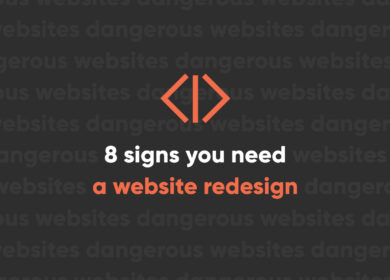
Everything You Need to Know Before Adding Pop-ups to Your Website

As a website user, you probably hate pop-ups. But as a business owner, web designer or marketer, you sometimes have to put your personal feelings aside.
Contrary to what many people say, pop-ups are not the root of all evil. Sometimes they are useful—both to you as a website owner and to your users. Of course, in order to make them useful, you have to follow some best practices.
Wait, Doesn’t Google Penalize Sites with Pop-ups?
Okay, before we can even get into best practices for pop-ups, we have to address to the google-sized elephant in the room. You may have heard rumors that Google has unleashed its wrath on any websites with pop-ups. Certain fear mongers out there would have you believe that pop-ups will lead to massive ranking decreases or your website being dropped from Google search results completely. But that’s pretty far from the truth.
Yes, Google does discourage the use of intrusive pop-ups and interstitials, particularly on mobile devices. Google wants your content to be easily accessible as soon as a user lands on your site. Google does not want this:

But your website has to do more than simply please Google. It has to serve your purposes as well. The good news here is that Google isn’t out to get websites that use pop-ups.
Here’s Google’s official policy on the matter:
To improve the mobile search experience, after January 10, 2017, pages where content is not easily accessible to a user on the transition from the mobile search results may not rank as highly.
That doesn’t exactly sound like popupgeddon. Google even goes on to further lessen the weight of this so-called penalty:
This new signal is just one of hundreds of signals that are used in ranking and the intent of the search query is still a very strong signal, so a page may still rank highly if it has great, relevant content.
In other words, this whole pop-up thing sounds like a tiny ranking signal that’s not nearly as important as what else is on your website.
Okay, so now that we have that out of the way, it’s safe to say that you can use pop-ups without fear of being vaporized by Google. But that doesn’t mean you should use pop-ups with reckless abandon. If you follow a few best practices, you can create effective pop-ups that don’t make your users hate you—and maybe even improve the user experience.
Don’t Use Pop-ups If You Don’t Need Them
The first rule about pop-ups is simple: use them only if you need them. Never add a pop-up for the sake of adding a pop-up. A pop-up should be designed to serve a purpose. In some cases, you have to use them. Maybe your website requires age verification. Or maybe you have a legal obligation to share a message with your visitors. It’s important to note that these types of pop-ups will not have any negative impact on your Google performance. But what about marketing pop-ups that you feel like you need? For example, maybe you want a pop-up to increase your email list subscription rate. Or one to announce a big sale/event. Or maybe one to catch people before they leave your website without making a purchase. These can all be beneficial if implemented the right way. Before adding any of these, see if there’s another way you can accomplish the same goal without it. If after careful consideration you feel like you need the pop-up to accomplish the job, then go ahead and enable it.
Measure Their Performance
If you’re going to use a pop-up, you have to know how it’s affecting your website’s performance—for both better and for worse. That means you need to use a variety of metrics to measure success. Let’s say you decide to add a pop-up to collect more email subscribers. Of course one of your metrics is going to be email signups. But if you only look at email signups, you might miss the fact that your bounce rate skyrocketed and your revenue decreased after enabling a pop-up. A few extra email addresses on your list probably aren’t worth decreased website performance and lost sales. But a lot more emails on your list might be worth a slight increase in your bounce rate. You have to know what you’re measuring, and you have to know how to weigh those results.
Design Pop-Ups to Fit Your Website and Brand
By their very nature, pop-ups should stand out. If they blend in, they probably won’t have much impact. But that doesn’t mean they should be eyesores. Your pop-up is an extension of your website, and it should fit within your brand. Don’t just slop something together and throw it up on the site. Use an actual design process to create something that represents your company with the same standards as the rest of your website.
Make Pop-ups Easy to Use—and Easy to Close
A pop-up shouldn’t make your website harder to use. At worst, it should be a momentary and very slight inconvenience for your user. It should have a clear message and a clear call to action. Your user should never be greeted with a pop-up that makes them wonder what to do next. Even more importantly, it needs to be easy to get out of the pop-up. Most of your users probably don’t need to use the pop-up to complete their reason for visiting, so you better make it stupidly simple for them to close it and move on with their purpose for being on your website.
Don’t Overshow Pop-ups
The one thing that’s unquestionably more annoying than a pop-up is seeing the same pop-up every time you visit a website. Or, even worse, seeing that same pop-up on every page of the website. If you visit the same website five times and get the same pop-up to sign up for their email list—especially if you are already on it—every time, you’re not going to have a very positive impression of that company or their technology. Your pop-up should rely on cookies to make sure it doesn’t keep going out to the same visitors on the same devices. Once the user has seen it, do everything you can to make sure that user doesn’t see it again.
Have a Plan to Turn Them Off
You can’t rely on pop-ups forever. They should generally be temporary solutions, and you should almost always be looking for another way to accomplish the same goal. Whenever you enable a pop-up, it’s quite likely that it will lead to a negative performance somewhere. It may not always be a net negative performance, but you’re going to have some visitors who leave your website just because of the pop-up. Even though the end result might be in your favor, you don’t want to keep losing those other customers forever. Before enabling a pop-up, have a plan for how long you want to keep it up, and know what metrics are going to make you turn it off ahead of schedule.
The Final Word on Pop-ups
Ask people if they like pop-ups and inevitably most of the responses will be negative. But the funny thing is that they still work in spite of the intense hatred people have for them. As long as you have a plan and a purpose, you can be confident that pop-ups will be helpful rather than harmful for your overall goals.

Nate Tower
Nate Tower is the President of Perrill and has over 12 years of marketing and sales experience. During his career in digital marketing, Nate has demonstrated exceptional skills in strategic planning, creative ideation and execution. Nate's academic background includes a B.A. with a double major in English Language and Literature, Secondary Education, and a minor in Creative Writing from Washington University. He further expanded his expertise by completing the MBA Essentials program at Carlson Executive Education, University of Minnesota.
Nate holds multiple certifications from HubSpot and Google including Sales Hub Enterprise Implementation, Google Analytics for Power Users and Google Analytics 4. His unique blend of creative and analytical skills positions him as a leader in both the marketing and creative worlds. This, coupled with his passion for learning and educating, lends him the ability to make the complex accessible and the perplexing clear.



